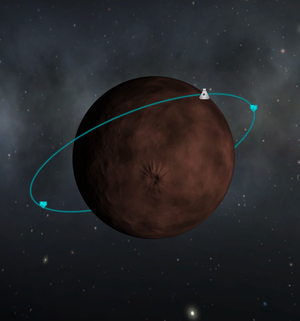Difference between revisions of "Orbit"
From Kerbal Space Program Wiki
(Minor improvements.) |
m (Mention Ap/Pe indicators in the map view.) |
||
| Line 3: | Line 3: | ||
[[File:MohoSmall.png|thumb|right|A spacecraft in orbit around [[Moho]].]] | [[File:MohoSmall.png|thumb|right|A spacecraft in orbit around [[Moho]].]] | ||
| − | An '''orbit''' is an [[w:ellipse|elliptical]] path around a celestial body. The point on an orbit which is closest to the orbited body is called the ''periapsis''; the furthest point is the ''apoapsis''. | + | An '''orbit''' is an [[w:ellipse|elliptical]] path around a celestial body. The point on an orbit which is closest to the orbited body is called the ''periapsis''; the furthest point is the ''apoapsis''. (These points are indicated on the [[map view]] as "Pe" and "Ap", respectively.) |
An orbit is considered "stable" if all points in the orbit are above the terrain and atmosphere of the orbited body. A spacecraft in such an orbit will not lose velocity due to atmospheric drag or collisions with terrain. | An orbit is considered "stable" if all points in the orbit are above the terrain and atmosphere of the orbited body. A spacecraft in such an orbit will not lose velocity due to atmospheric drag or collisions with terrain. | ||
Revision as of 17:27, 31 October 2012

A spacecraft in orbit around Moho.
An orbit is an elliptical path around a celestial body. The point on an orbit which is closest to the orbited body is called the periapsis; the furthest point is the apoapsis. (These points are indicated on the map view as "Pe" and "Ap", respectively.)
An orbit is considered "stable" if all points in the orbit are above the terrain and atmosphere of the orbited body. A spacecraft in such an orbit will not lose velocity due to atmospheric drag or collisions with terrain.
To achieve orbit, a spacecraft must reach a sufficient altitude and orbital velocity. During ascent, a gravity turn helps to achieve both of these goals in a fuel-efficient way.